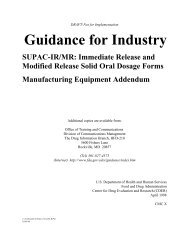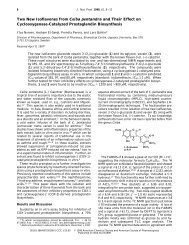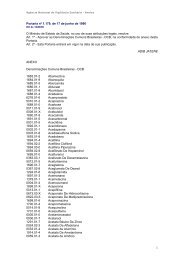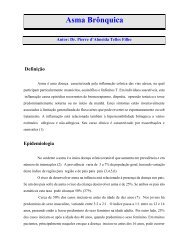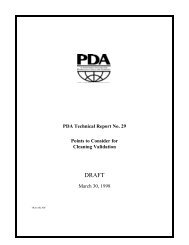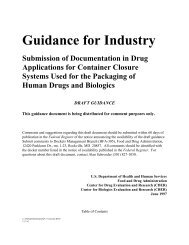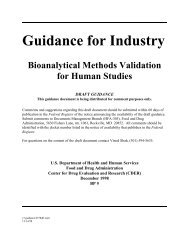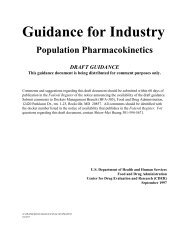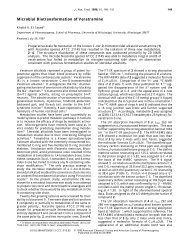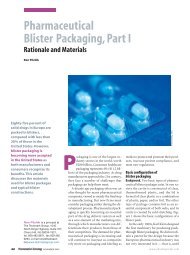ANDAs impurities in drug substances - Pharmanet
ANDAs impurities in drug substances - Pharmanet
ANDAs impurities in drug substances - Pharmanet
- No tags were found...
You also want an ePaper? Increase the reach of your titles
YUMPU automatically turns print PDFs into web optimized ePapers that Google loves.
Draft-Not for Implementation144145146147148149150151152153154155156157158159160161<strong>impurities</strong> that are present but are below the validated limit of quantitation (LOQ) need not bereported.If analytical procedures change dur<strong>in</strong>g development, reported results should be l<strong>in</strong>ked with theprocedure used and appropriate validation <strong>in</strong>formation should be provided. Representativechromatograms should be provided. Chromatograms of such representative batches, frommethods validation studies show<strong>in</strong>g separation and detectability of <strong>impurities</strong> (e.g., on spikedsamples), along with any other impurity tests rout<strong>in</strong>ely performed, can serve as the representativeimpurity profiles. The applicant or DMF holder should ensure that complete impurity profiles(i.e., chromatograms) of stability batches are available if requested. A tabulation should beprovided compar<strong>in</strong>g impurity levels between stability and other batches.For each batch of the <strong>drug</strong> substance, the report should <strong>in</strong>clude:! Batch identity and size! Date of manufacture! Site of manufacture! Manufactur<strong>in</strong>g process! Impurity content, <strong>in</strong>dividual and total! Use of batches! Reference to analytical procedures used162VI.ACCEPTANCE CRITERIA FOR IMPURITIES163164165166167168169170171172173174175176177The specification for a <strong>drug</strong> substance should <strong>in</strong>clude acceptance criteria for <strong>impurities</strong>. Stabilitystudies, chemical development studies, and rout<strong>in</strong>e batch analyses can be used to predict those<strong>impurities</strong> likely to occur <strong>in</strong> the commercial product. The selection of <strong>impurities</strong> to <strong>in</strong>clude <strong>in</strong> the<strong>drug</strong> substance specification should be based on the <strong>impurities</strong> found <strong>in</strong> the batch(es)manufactured by the proposed commercial process. Those <strong>impurities</strong> selected for <strong>in</strong>clusion <strong>in</strong> thespecification for the <strong>drug</strong> substance are referred to as specified <strong>impurities</strong> <strong>in</strong> this guidance.Specified <strong>impurities</strong> may be identified or unidentified and should be <strong>in</strong>dividually listed <strong>in</strong> the <strong>drug</strong>substance specification (see below).A rationale for the <strong>in</strong>clusion or exclusion of <strong>impurities</strong> <strong>in</strong> the specification should be presented.This rationale should <strong>in</strong>clude a discussion of the impurity profiles observed <strong>in</strong> batches underconsideration, together with a consideration of the impurity profile of material manufactured bythe proposed commercial process. Specific identified <strong>impurities</strong> should be <strong>in</strong>cluded along withrecurr<strong>in</strong>g unidentified <strong>impurities</strong> estimated to be at or above 0.1 percent. For <strong>impurities</strong> known tobe unusually potent or to produce toxic or unexpected pharmacological effects, thequantitation/detection limit of the analytical methods should be commensurate with the level atJ:\!GUIDANC\2452DFT.WPDJuly 21, 19986



